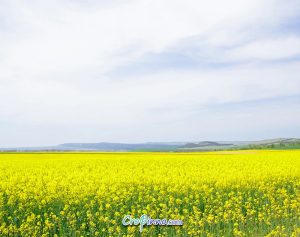Canola is a type of rapeseed that was developed in Canada in the 1970s through plant breeding. Canola plants may grow to be two to six feet tall and produce beautiful yellow blossoms. Each blossom develops a pod that contains canola seeds. These seeds are used to produce the popular canola cooking oil and canola meal, which is used in animal feed. Canola may also be used to generate biodiesel, which has been shown to cut greenhouse gas emissions by up to 90 percent when compared to petroleum-based diesel. In the 1990s, researchers used plant science to develop herbicide-resistant canola. This allows a farmer to use herbicide to manage weeds that may compete for water and nutrients with the canola without harming the crop. Farmers can utilize no-till or conservation tillage, which lowers soil degradation, improves quality of soil, reduces greenhouse gas emissions, and reduces water consumption. Herbicide-tolerant canola also allows farmers to boost yields on current fields, which actually helps in biodiversity conservation.
Canada is the world’s largest producer of canola, which is planted throughout the country and is one of the most significant crops for Canadian farmers due to the money it brings. In 2018, more than 20 million metric tonnes of canola were produced, with Saskatchewan fields accounting for more than half of this total. Now it is time to learn some very interesting facts about canola, how it got its name, and where it stands in the agriculture industry.
The Name Origin
In 1978, The words “Canada” and “Ola” (denoting oil) were combined to create the term “canola”. This crop, known as “Canadian oil,” is the only crop literally produced for the first time in Canada and was developed by scientists through crossbreeding of the rapeseed plant.
The Healthiest Among Them All
Canola oil is the world’s healthiest cooking oil. It comes from pressed canola seeds and is a rich source of vitamin E, cholesterol free and contains the least amount of saturated among all common cooking oils.
More Oil than Soybean Seeds
44% of the canola seed is oil, more than double the amount of oil contained in soybean seeds. The remainder is known as canola meal, which is used as a protein source in animal feeds globally.
2X Production
Farmers can produce twice as much canola with the use of pesticides and biotechnology as compared to what they could grow without plant science.

Smaller Land, Bigger Score
If it weren’t for the pesticides & plant biotechnology, Canola farmers would need an additional area of land equal to 14 million football fields to produce the same quantity of canola they do now.
Contributing to Economy
More than 249,000 Canadian jobs and $12.5 billion in salaries are supported by the canola industry, which makes a nearly $20 billion annual contribution to the Canadian economy.
For Export Purposes, Mostly
Canada is the largest exporter of canola, but that wasn’t unexpected, right? Still, it is interesting to know that 90% of canola seed, oil, and meal produced in Canada is for export purpose. Canola travels from Canada to around 50 markets (countries) around the world.
Less Environmental Impact
According to research studies, cultivating biotech canola crops can decrease soil erosion by 86 percent, and farmers can save an estimated one billion kilograms of CO2 – equivalent to removing over 500,000 cars from the road – by having to till their fields less.
Dealing with Drought
Just like any other crop, Canola also suffers from climate change, drought & water shortage. In 2021, canola production in Canada decreased by 35.4% to 12.6 million tonnes, as the drought in Western Canada resulted in the lowest yield since 2007. Yields decreased by 40.2% to 25.0 bushels per acre. In such situation, only better, more optimized water management methods may help with controlling the negative effects of a global drought.

